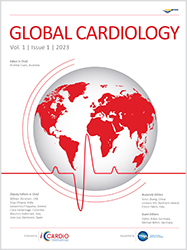Lipoprotein(a): what clinicians need to know
All claims expressed in this article are solely those of the authors and do not necessarily represent those of their affiliated organizations, or those of the publisher, the editors and the reviewers. Any product that may be evaluated in this article or claim that may be made by its manufacturer is not guaranteed or endorsed by the publisher.
Authors
Lipoprotein(a) [Lp(a)] is a plasma particle structurally similar to LDL, distinguished by the presence of apolipoprotein(a), and has evolved from plasminogen. Lp(a) concentration is 90% genetically determined and largely stable throughout life. Black individuals exhibit the highest Lp(a) levels, followed by South Asians, Whites, Hispanics, and East Asians, with a 2- to 4-fold median difference across ancestral groups. Approximately 1.5 billion people worldwide (~20% of the population) have elevated Lp(a) levels (>125 nmol/L or >50 mg/dL). Notably, women experience 17% higher levels than men post-menopause. Mendelian randomization studies have established Lp(a) as a strong cardiovascular disease (CVD) risk factor, implicated in coronary artery disease, peripheral artery disease (PAD), ischemic stroke, heart failure, and aortic stenosis. Risk increases linearly with Lp(a) levels, with concentrations >90 mg/dL (>190 nmol/L) associated with a 1.6-fold higher risk of ischemic stroke, 1.7-fold for heart failure, 2-fold for PAD, and 3-fold for aortic stenosis and myocardial infarction. Lp(a) levels between 130–391 mg/dL (280–849 nmol/L) confer atherosclerotic CVD risk equivalent to familial hypercholesterolemia. Universal screening of once Lp(a) test is now recommended for all adults in guidelines across the US, Europe and Canada. However, Lp(a) testing is severely underutilized with studies showing 0.3% testing frequency amongst 5.5 million US patients. Even in high-risk patients with established ASCVD, only 13.9% are tested for Lp(a). Existing treatment options for elevated Lp(a) include proprotein convertase subtilisin/kexin type 9 (PCSK9) inhibitors and lipoprotein apheresis. Emerging therapies include antisense oligonucleotides such as pelacarsen, small-interfering RNA such as zerlasiran, olpasiran, and lepodisiran, and oral agents such as muvalaplin. These medications have shown a significant reduction in plasma levels up to 80% (pelacarsen), 96.9% (olpasiran), 97% (lepodisiran) and 99% (zerlasiran) in phase 1 and 2 trials, with larger studies ongoing to assess cardiovascular outcomes. With advancing therapies, clinician awareness, early detection, and risk management of Lp(a) are critical to improving outcomes.
How to Cite

This work is licensed under a Creative Commons Attribution-NonCommercial 4.0 International License.








